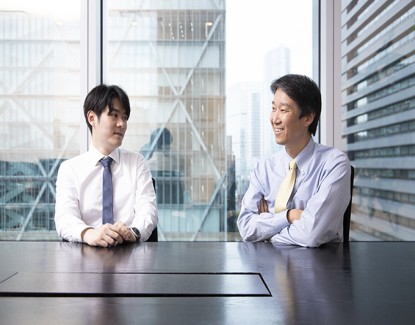Market Commentary and Fund Performance
The Portfolio Managers of Tokyo-based SPARX Asset Management Co., Ltd., sub-advisor to the Hennessy Japan Fund, share their insights on the Japanese market and Fund performance.
-
 Masakazu Takeda, CFA, CMAPortfolio Manager
Masakazu Takeda, CFA, CMAPortfolio Manager
Performance data quoted represents past performance; past performance does not guarantee future results. The investment return and principal value of an investment will fluctuate so that an investor’s shares, when redeemed, may be worth more or less than their original cost. Current performance of the fund may be lower or higher than the performance quoted. Performance data current to the most recent month end, and standardized performance can be obtained by viewing the fact sheet or by clicking here.
Fund Performance Review
In April 2025, the TOPIX rose by 5.19% compared to the end of the previous month. The Japanese stock market experienced significant volatility during the month, driven by uncertainty surrounding U.S. trade and monetary policies.
In the first half of the month, concerns about stagflation in the U.S. intensified. The Trump administration announced reciprocal tariffs of up to 50% globally, prompting immediate retaliatory measures from China and the European Union (EU).
This created a widespread risk-averse sentiment globally. As a result, the Japanese stock market plunged sharply, with the futures market triggering a circuit breaker, amplifying the turmoil. However, on the 9th, when the U.S. government announced a 90-day suspension of some tariffs, the overly pessimistic mood began to ease, and the market rebounded strongly. On the 10th, nevertheless, the U.S. clarified its intention to raise total tariffs on China to 145%, reigniting market caution.
Additionally, U.S. President Trump called for interest rate cuts from the Federal Reserve, and concerns about the possible dismissal of Chairman Jerome Powell fueled growing distrust in the Fed’s independence. As a result, U.S. markets experienced a triple whammy with declines in stocks, bonds, and the dollar, and Japan’s stock market also faced a challenging environment with limited upward movement.
On the other hand, on the 22nd, U.S. Treasury Secretary Janet Yellen stated that “tariffs are unsustainable,” and on the 23rd, reports emerged that President Trump had denied plans to dismiss Chairman Powell, which reassured the market. Additionally, reports suggesting that the U.S. might review its tariffs on China were positively received, and expectations of a de-escalation in U.S.-China tensions helped boost risk appetite. As a result, the Japanese stock market closed the month with a gain compared to the end of the previous month.
This month, the Fund returned 2.22% (HJPIX), underperforming its benchmark, the Russell/Nomura Total Market™ Index, which returned 4.71%.
The month’s positive performer among the Global Industry Classification Standard (GICS) sectors included shares of Industrials, Consumer Discretionary, and Consumer Staples while there were no sectors detracted from the Fund’s performance.
Among the best performers were our investments in Hitachi, Ltd., one of Japan’s oldest electric equipment & heavy industrial machinery manufacturers, Recruit Holdings Co., Ltd., Japan’s unique human resources (HR) and media company and the owner of U.S.-based online job advertisement subsidiary “Indeed” and Tokyo Electron Limited, one of the world’s largest manufacturer of semiconductor production equipment.
As for the laggards, Mitsubishi UFJ Financial Group, Inc., one of Japan’s largest financial groups, Renesas Electronics Corporation, Japan’s largest semiconductor maker specializing in MCUs and analog chips and ORIX Corporation, Japan’s largest non-bank comprehensive financial services company, were the largest detractors.
Seven & i Holdings Update
Seven & i Holdings announced its full-year results for the fiscal year ended in February 2025. The company reported a 4% year-on-year increase in revenue while operating profit declined by 21%. Despite the drop in profitability, it did exceed the company’s revised forecast by 4%.
The strategy for the future was outlined by Mr. Steve Dacus, who is expected to assume the role of president subject to approval at the next AGM in May. His statement, “We have historically been a bit conservative. This has led to us moving slower than we should and missing opportunities. It has impacted our ability to execute. This is something I intend to change,” stood out as a defining remark.
When we met with Mr. Dacus last September, he had already emphasized, in his capacity as an outside director at the time, that the company’s slow decision-making process was a key challenge. This view stems from his experience working in the overseas UNIQLO division at Fast Retailing, where he learned the importance of swift decision-making and execution in retail from the company’s founder and CEO, Mr. Tadashi Yanai. Mr. Dacus’s recent public commitment to “faster execution” is consistent with his earlier perspective.
While his leadership abilities remain untested, the market’s skepticism presents an opportunity to focus on his potential. We intend to continue monitoring his performance closely. Considering the company’s valuation, which appears to be attractively low, along with its potentially limited downside risk, we believe this is a situation where a contrarian approach is warranted.
The company has also announced a major shareholder return initiative worth a whopping 600bn yen ($4.1bn), involving the repurchase of up to 400mn shares. The buyback period runs from April 10, 2025, to February 28, 2026, amounting to about 15% of outstanding shares (excluding treasury stock already held). If the entire amount is executed evenly over the 218 days, the daily purchase would average 2.75bn yen ($18.8mn) or 1.83mn shares. This represents approximately 12%–16% of the daily average trading volume over the past three months (23.2bn yen/$159mn or 10.57mn shares), likely creating a significant impact on the stock price.
This buyback plan is aimed at appeasing existing shareholders, particularly as the company continues to face sluggish same-store sales and diminishing prospects for acquisition that emerged last year.
Some critics have questioned the company’s decision to allocate capital toward shareholder returns instead of prioritizing business recovery. However, we do not see this as a major issue. Over the past two years, despite weak same-store sales, the company has consistently generated robust operating cash flows, and the inherent strength of the convenience store segment’s cash flow generation remains evident.
According to the cash flow statement, some of the FY20241 performance appears to have been boosted by reductions in working capital. However, as we discussed in our June 2023 and February 2024 commentaries, it is important to analyze Seven & i Holdings’ capabilities by excluding the cash flow fluctuations caused by Seven Bank,2 a group subsidiary. The Japanese accounting standards adopted by the company treat changes in deposits and call loans as part of operating cash flow, which can obscure the true performance of its core convenience store operations. This differs from the U.S. accounting practices, where such items are typically classified under investing or financing activities.
On the investment side, the company’s average annual cash flow from investing activities has been approximately 400bn yen ($2.7bn) in recent years, excluding non-recurring items such as the full acquisition of its Australian 7-Eleven operations last fiscal year. This suggests that the company’s normalized free cash flow is approximately 400bn yen ($2.7bn) annually. If fully allocated to shareholder returns, this would represent a yield of about 8% today. Additionally, the scheduled sale of York Holdings3 shares this year is expected to provide a substantial one-time cash inflow.
Looking ahead, management is also considering an equity carve-out for its U.S. subsidiary, 7-Eleven, Inc. (SEI). The primary objective of listing SEI is to unlock its value and secure additional funds for shareholder returns. Based on SEI’s operating profit forecast of $2.3bn for this fiscal year (up 5.8% year-on-year), and assuming a price to earnings (P/E) multiple of 20x, the estimated market capitalization would be $32–35bn (approximately 5tn yen/$34.3bn). Selling 10–20% of SEI’s shares could generate approximately 400-600bn yen ($2.7 - $4.1bn) in post-tax proceeds, according to our estimates.
Per management’s capital allocation framework, which incorporates these cash flows, management outlines plans to generate 7.5tn yen ($51.4bn) (1,250bn yen/$8.6bn annually) in cash inflows over the six years from FY2025 to FY2030. Of this amount, 3.2tn yen ($21.9bn) (530bn yen/$3.6bn annually) will be allocated to growth investments, 2.8tn yen ($419.2bn) (470bn yen/$3.2bn annually) to shareholder returns, and 1.4tn yen ($9.6bn) (230bn yen/$1.6bn annually) to debt repayments.
Given that the company’s core operating cash flow is currently around 800bn yen ($5.5bn) annually as mentioned above, the remaining 450bn yen ($3.1bn) per year (2.7tn yen/$18.5bn over six years) will be supplemented by proceeds from the sale of York Holdings shares and the potential listing of SEI. Although any potential shortfall will require the company to enhance its operating cash flow through "faster execution," we believe it can be achievable without being overly ambitious.
In conclusion, we believe Seven & i Holdings is well-positioned to balance high shareholder returns with sufficient growth investments. Although the pace of reducing the debt accumulated during the 2020 acquisition of Speedway may slow, the presence of debt could well serve as a motivator for management to operate with greater discipline.
Policies of the Trump Administration
The Trump administration's tariff policies have significantly impacted global stock markets, drawing criticism from media and economic experts for their perceived one-sidedness. Markets reacted negatively to the tariffs from the start.
However, we do not necessarily view the current situation negatively when looking at the various policy measures drawn up by the Trump administration holistically. This is because the policy framework has a certain rationality. We believe that the U.S. strategy will be beneficial in the long term for Japanese companies with global reach that the Fund invests in.
Fiscal Deficits and Government Debt
The U.S. urgently needs to address its massive budget deficit, which has grown significantly since the Biden administration. It must also curb the rapid growth of government debt. Since 2022, market interest rates have increased substantially. If left unchecked, this could lead to a "debt spiral," where rising interest costs create a vicious cycle that could “snowball” out of control.
The U.S. budget deficit and debt problem is not caused by a lack of revenue but by overspending.
To address this issue, the Trump administration plans to:
• streamline and improve the efficiency of the public sector
• the planned reduction in taxes
• revitalize the private sector through deregulation
• reduce energy costs and
• raise tariffs
As it relates to the first point, the Department of Government Efficiency (DOGE) led by Tesla founder Elon Musk is currently focusing on the high cost structure. DOGE is uncovering potentially fraudulent pension claims and unused funds resulting from outdated government IT systems. Cuts to governmental spending and cost savings of $1tn are being targeted.
While DOGE cuts unnecessary expenditures at once, on the revenue side, there is a risk of a decrease in tax revenues because it has proposed tax cuts. However, the Trump administration aims to raise the potential growth rate of the U.S. economy through revitalizing the private sector and reducing energy costs, which in turn could strengthen revenues. The idea is to shrink "big government" and achieve private-sector-led economic growth. Specific measures for deregulation will be announced later this year.
Our fifth point is that tariffs can be regarded as a consumption tax imposed on foreign products because the price is ultimately passed on to American consumers. Some people may say that it is not fair to impose a tax burden on foreign countries, but in fact, the tariff rates imposed on foreign products flowing into the U.S. have generally been much lower than the tariffs imposed on U.S. goods by these exporting countries for decades. This was begun when the U.S. opened its markets to promote the economic recovery of other countries that had been devastated by World War II. Since then, we have maintained these unequal tariffs in favour of exporting countries.
Implementing stricter tariffs also serves a critical military purpose by promoting and potentially restoring some U.S. manufacturing. During the Cold War, the U.S. effectively countered the former Soviet Union through military strength. Today, China has emerged as its primary rival as a hegemonic power, necessitating preparedness to counter its influence. It is desirable to have a self-sufficient system for armaments production. For example, currently, the U.S. shipbuilding industry, crucial for warship manufacturing, has shrunk significantly compared to China's. This perspective is vital to ensuring economic security.
Tariffs may incentivize a return to manufacturing in the U.S. while generating additional revenue. This approach differs significantly from the Biden administration's subsidy policies, such as the CHIPS Act and the IRA Act. Contrary to the Biden administration's approach, which effectively provided foreign entities with incentives to enter the U.S., Trump’s tariffs offer a distinctly different, and polarising solution to this challenge. If foreign companies are deterred by high tariffs, they may opt to invest in U.S.-based production sites, thereby creating jobs. Alternatively, tax revenues will be bolstered through customs duties.
Through all these measures, the Trump administration aims to reduce the budget deficit, end the debt spiral fears, lower long-term interest rates, cool inflation, and raise private-sector-led economic growth.
Where the Tariff Regime will be Headed
Despite the purported benefits of the new tariffs, the key intention, we feel, is for the U.S. to promote equal tariffs, also known as reciprocal tariffs. In other words, if the other country lowers its tariffs, the U.S. is prepared to do so. These efforts, therefore, should not necessarily be interpreted as a shift toward protectionism or isolationism.
In principle, the world economy thrives on free trade. As such, the best policy for each country should be the elimination of all tariffs as well as non-tariff barriers, creating a truly level playing field. Furthermore, in the event of trade imbalances, countries should commit to a floating exchange rate system free from currency interventions, serving as a self-correcting adjustment mechanism.
While this may take some time to achieve, we should all closely monitor how much understanding and commitment the U.S. and other nations—particularly China—can demonstrate in moving toward this goal. Japan, as a forerunner in engaging in trade talks with the U.S. currently, could set a precedent for many countries to follow suit.
Current Account Deficits
Current account deficits are also talked about as a grave issue together with the fiscal deficits in the context of the "twin deficits." However, it is interesting how there are divisions in opinions among the “experts.” Those in academia (Milton Friedman, Ben Bernanke, Paul Krugman, and so-called MMT economists, etc.) tend to dismiss the issue, arguing that the U.S.'s ability to run large deficits is a sign of economic strength rather than weakness and that its global leadership and the U.S. dollar’s status as a reserve currency are entrenched due to lack of viable alternatives.
On the other hand, from time to time, legendary investors (Warren Buffett, George Soros, Stanley Druckenmiller, Ray Dalio, etc.) have expressed significant concerns citing the dangers of reliance on foreign capital to fund the U.S.'s spending habits, potentially undermining the long-term economic stability.
When it comes to macro predictions, we tend to gravitate towards the view of market practitioners (among scholars, Paul Volcker, the former Fed chairman, and the Nobel Prize-winning economist Joseph Stiglitz were also deeply skeptical about the sustainability of the U.S. economic model).
If the current trend of over-consumption and under-investment continues, the U.S. economy may be at the mercy of foreign creditors in the future, especially nations like China, which hold large amounts of U.S. treasuries. Such a situation makes the U.S. more vulnerable to not only financial shocks but also geopolitical threats. As the world starts to diversify away from dollar-denominated assets, it could lead to a steep depreciation of the currency, higher inflation, higher interest rates, and a prolonged recession in the U.S.
How the Fund is Positioned
Whatever the new world order may bring, in the long run, all eyes are on the implications of the newly introduced U.S. tariffs for the foreseeable future. In this regard, we believe that most of the stocks held in the Fund will be only minimally impacted.
Firstly, many of the companies with significant business operations in the U.S. are primarily in non-manufacturing sectors that are not subject to tariffs. Examples include Tokio Marine Holdings in the non-life insurance sector, Recruit Holdings in internet services, Seven & i in retail, Sony Group with its focus on entertainment (such as PlayStation gaming software, music, and movies), and ORIX in financial services.
As for the manufacturing companies in the portfolio, firms producing highly differentiated, high-margin products are generally well-positioned to absorb the impact of tariffs. Examples include Hitachi in its large-scale power transformer business and Keyence with its factory automation sensors. These are fundamentally different from the low-cost, low-value-added products exported in large volumes from China to the U.S.
Additionally, some manufacturers have already established robust value chains within the U.S. For instance, Shin-Etsu Chemical’s PVC business operates an integrated production system in Louisiana and Texas, covering everything from raw material ethylene to finished PVC products.
It is also worth noting that only a small number of the companies in the Fund rely on low-cost production in China as a core business model for overseas expansion, such as Sony Group's hardware business in the PlayStation segment. Moreover, none of the companies in the portfolio depend on complex global supply chains that integrate low-wage countries. Should high tariffs become a long-term reality, companies relying on such supply chains may face challenges in restructuring their operations.
However, the indirect effects of the tariffs are harder to predict. These could include potential slowdowns in the global economy leading to weaker earnings, rising U.S. long-term interest rates, or yen appreciation. We will continue to closely monitor for any structural changes in the business models of the companies in our portfolio and adjust our views accordingly.
Fund Performance and Valuation
Although some portfolio names have experienced significant declines since the beginning of the year, this is more likely due to market volatility than any sharp deterioration in fundamentals. It is probable that short-term trade-oriented market participants with tight risk limits, such as hedge funds, have been selling off highly liquid large-cap stocks to avoid losses or shrink their exposure amid the extreme market gyrations. This can be confirmed through the April 5th Financial Times article "Hedge funds hit with steepest margin calls since 2020 Covid crisis."4
The good news is that the valuation of our portfolio has become increasingly attractive relative to the quality of our holdings as well as the overall market. The return on equity (ROE) of the Fund is comfortably higher than average Japanese companies (Fund % vs TOPIX index %), yet the P/E of the Fund is lower than that of the TOPIX (Fund x vs TOPIX x).
It gets even more compelling when we look at some of our top holdings up close. For instance, Seven & i Holdings currently trades at approximately 20x forward accounting earnings per share (EPS) of 101.96 yen ($0.96). However, the reality is, that based on the pre-goodwill amortization EPS of 143.96 yen ($0.99), which is a fairer proxy for its true earning power, the P/E is significantly lower at approximately 15x. ORIX is another example with a price to book ratio (P/B) of 0.77x based on the statutory BPS. However, on a net asset value (NAV) basis, a fairer yardstick for an investment company like ORIX is trading at only 0.5x based on our estimate.
While the Fund is not immune to the short-term vagaries caused by the market dynamics, we view these situations as excellent buying opportunities, as we demonstrated amid last year's August stock market turbulence triggered by the unwinding of the yen carry-trades.
We adhere to our investment philosophy of “Invest in great businesses with exceptional management at an attractive price,” focusing on Japanese global companies. Businesses with a global market reach are inherently more "attractive" than those limited to Japan’s smaller domestic market. By investing in Japanese global companies, we aim to achieve sustained, long-term growth in stock prices.
Click here for a full listing of Holdings.
- In this article:
- Japan
- Japan Fund
1 Feb 2025.
2 Seven Bank will be de-consolidated this year. Excluding these factors, the company’s core operating cash flow has indeed remained stable at around 800bn yen ($5.5bn) annually over the past three fiscal years, including the most recent peak in FY2022, before same-store growth in Japan and the U.S. turned negative.
3 The group's intermediate holding company overseeing non-core retail businesses. It will be sold to Bain Capital for 814.7bn yen ($5.6bn).
You might also like
-
 Portfolio Perspective
Portfolio Perspective
Japan Small Cap FundA Focus on Japanese Small-Caps Making Big Corporate Improvements
 Takenari Okumura, CMAPortfolio Manager
Takenari Okumura, CMAPortfolio Manager Tadahiro Fujimura, CFA, CMAPortfolio ManagerRead the Commentary
Tadahiro Fujimura, CFA, CMAPortfolio ManagerRead the CommentaryThe Portfolio Managers discuss their view of the Japanese small-cap corporate landscape amid many shifting factors, including a new Prime Minister, finalized tariff situation, currency volatility, and attractive valuation environment.
-
 Portfolio Perspective
Portfolio Perspective
Japan FundCompelling Japanese Opportunities Amid Attractive Valuations
 Masakazu Takeda, CFA, CMAPortfolio Manager
Masakazu Takeda, CFA, CMAPortfolio Manager Angus Lee, CFAPortfolio ManagerRead the Commentary
Angus Lee, CFAPortfolio ManagerRead the CommentaryThe Hennessy Japan Fund Portfolio Managers highlight the effect of the new Prime Minister on the economy and market and how holdings were affected by the final trade agreement. They also discuss currency volatility, valuations, and the most compelling opportunities as we end 2025.
-
 Investment Idea
Investment IdeaCompelling Valuations in Japan
 Masakazu Takeda, CFA, CMAPortfolio Manager
Masakazu Takeda, CFA, CMAPortfolio Manager Angus Lee, CFAPortfolio Manager
Angus Lee, CFAPortfolio Manager Tadahiro Fujimura, CFA, CMAPortfolio Manager
Tadahiro Fujimura, CFA, CMAPortfolio Manager Takenari Okumura, CMAPortfolio ManagerRead the Investment Idea
Takenari Okumura, CMAPortfolio ManagerRead the Investment IdeaJapanese equities are currently trading at compelling valuation levels compared to other developed equity markets around the world and relative to their own historical averages. We believe the Japanese market deserves a closer look.
